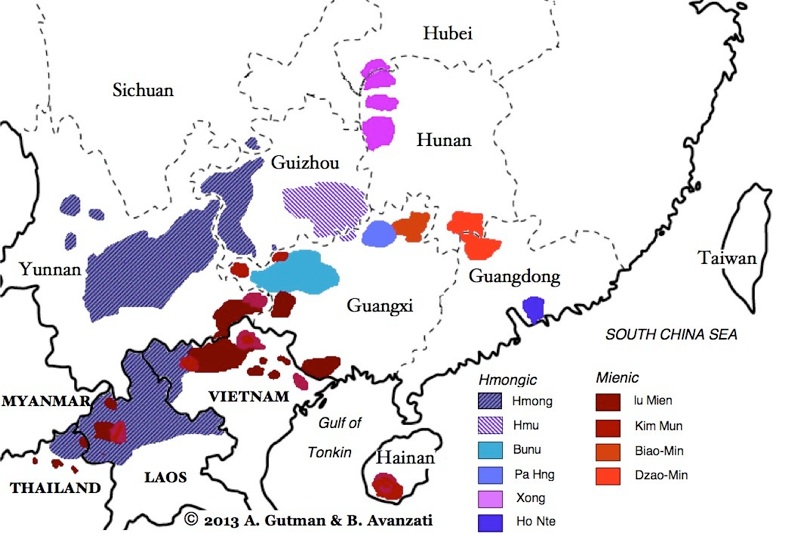An insatiable appetite for ancient and modern tongues


Alternative Name: Miao-Yao.
Overview. Hmong-Mien is a family of about thirty languages spoken by the Miao and Yao ethnic groups in south China and north South-East Asia. Though it shares a number of features with languages of the same area (Chinese, Tai-Kadai, and Mon-Khmer), it is considered genetically unrelated to them. Hmong-Mieng languages are monosyllabic and tonal, they have remarkable large consonant inventories and are non-inflective.
Distribution. The core of Hmong-Mien speakers lives in southern China, especially in Guizhou, Guangxi, Hunan and Yunnan provinces, having a lesser presence in Sichuan, Guangdong, Hubei, Jiangxi and in the island of Hainan. During the nineteenth and through the early twentieth century, they moved into northern Vietnam, Laos and Thailand, pressurized by the expansion of Han Chinese. Following the end of the Vietnam war, tens of thousands of Hmong-Mien speakers emigrated to France, USA and Australia.
Map of Hmong-Mien languages distribution

Internal Classification. Hmong-Mien is divided in two subfamilies, called Hmongic and Mienic (known by the Chinese as Miao and Yao). The main languages of the family are:

Speakers: due to imprecisions in the last Chinese census data, which confuses ethnicity with language, it is impossible to estimate accurately the number of Hmong-Mien speakers. It might range from 7 to 10 million of which 85 % in China.
SHARED FEATURES
-
✦ Phonology
-
- Word structure. Most Hmong-Mien words are monosyllabic. They start with one or more consonants followed by a vowel and, sometimes, by a final consonant.
-
- Consonants. Hmongic languages have a large number of initial consonants, including retroflex, uvular and glottal sounds, besides the usual labial, dental/alveolar, palatal and velar. Voiceless stops and affricates are more common than voiced ones. Stops and affricates can be aspirated or pre-nasalized, yielding a 4-way contrast: voiceless unaspirated, voiceless aspirated, voiceless prenasalized, and voiced. Those languages that do not have voiced stops (like Hmong) may pronounce a voiceless stop with both prenasalization and aspiration yielding a slightly different 4-way contrast in which all stops are voiceless: unaspirated, unaspirated prenasalized, aspirated, aspirated prenasalized.
-
Another interesting feature of Hmongic consonant systems is the occurrence of contrasting pairs of voiceless and voiced nasals (voiceless nasals are comparatively rare in world languages). The only permitted final consonants are the dental and velar nasals (n, ŋ). In contrast, the inventory of Mien initial consonants is smaller but more consonants are permitted in final position, including three nasals (m, n, ŋ) and three stops (p, t and glottal ʔ).
-
- Tones. All Hmong-Mien languages are tonal. Many have an exceptionally large number of tonal contrasts that can reach up to eleven or twelve. They serve to make lexical distinctions. As well as pitch contrasts, Hmong-Mien tones may have different voice qualities like 'breathy' or 'creaky'.
-
✦ Morphology
-
- Hmong-Mien are isolating languages. Nouns are not inflected for number, case or gender; verbs are not marked for tense, mood, person or number.
-
- New words can be formed by compounding and reduplication. Numeral classifiers are required when enumerating nouns.
-
- In contrast with Chinese, there are no suffixes and only a limited number of prefixes.
-
- Serial verb constructions are frequent. They involve two or more adjacent verbs (without any intervening conjunctions), all of them sharing the same subject. They usually express a sequence of closely related actions.
-
✦ Syntax
-
- Due to the complete absence of inflections, word order and adpositions are essential to determine syntactical relations. Normally, like in English, the subject precedes the verb which is followed by the object (SVO). Within the noun phrase, possessors and classifiers generally precede nouns, while adjectives follow the noun.
-
- Particles may be placed at the end of the phrase to express the state of mind of the speaker like uncertainty, confirmation, impatience, etc.
Lexicon. Hmong-Mien languages have a special kind of words called ideophones that evoke vivid sensations or sensory perceptions such as smell, color, sound, shape, movement, etc. Many are formed by reduplication and/or have an onomatopoeic character. The long coexistence with Chinese speaking peoples has led to a massive influx of Chinese loanwords.
-
© 2013 Alejandro Gutman and Beatriz Avanzati
Further Reading
-Hmong-Mien Language History. M. Ratliff. Australian National University (2010).
-'The Hmong–Mien languages'. D. Strecker. In Linguistics of the Tibeto–Burman Area 10(2), 1-11 (1987).
-The Languages of East and Southeast Asia. An Introduction. C. Goddard. Oxford University Press (2005)
-Language Atlas of China. S. A. Wurm. Longman (1987).
Hmong-Mien Languages

Address comments and questions to: gutman37@yahoo.com
MAIN LANGUAGE FAMILIES
LANGUAGE AREAS
Languages of Ethiopia & Eritrea
LANGUAGES by COUNTRY
LANGUAGE MAPS
-
• America
-
• Asia
-
Countries & Regions
-
-
Families
-
• Europe
-
• Oceania